







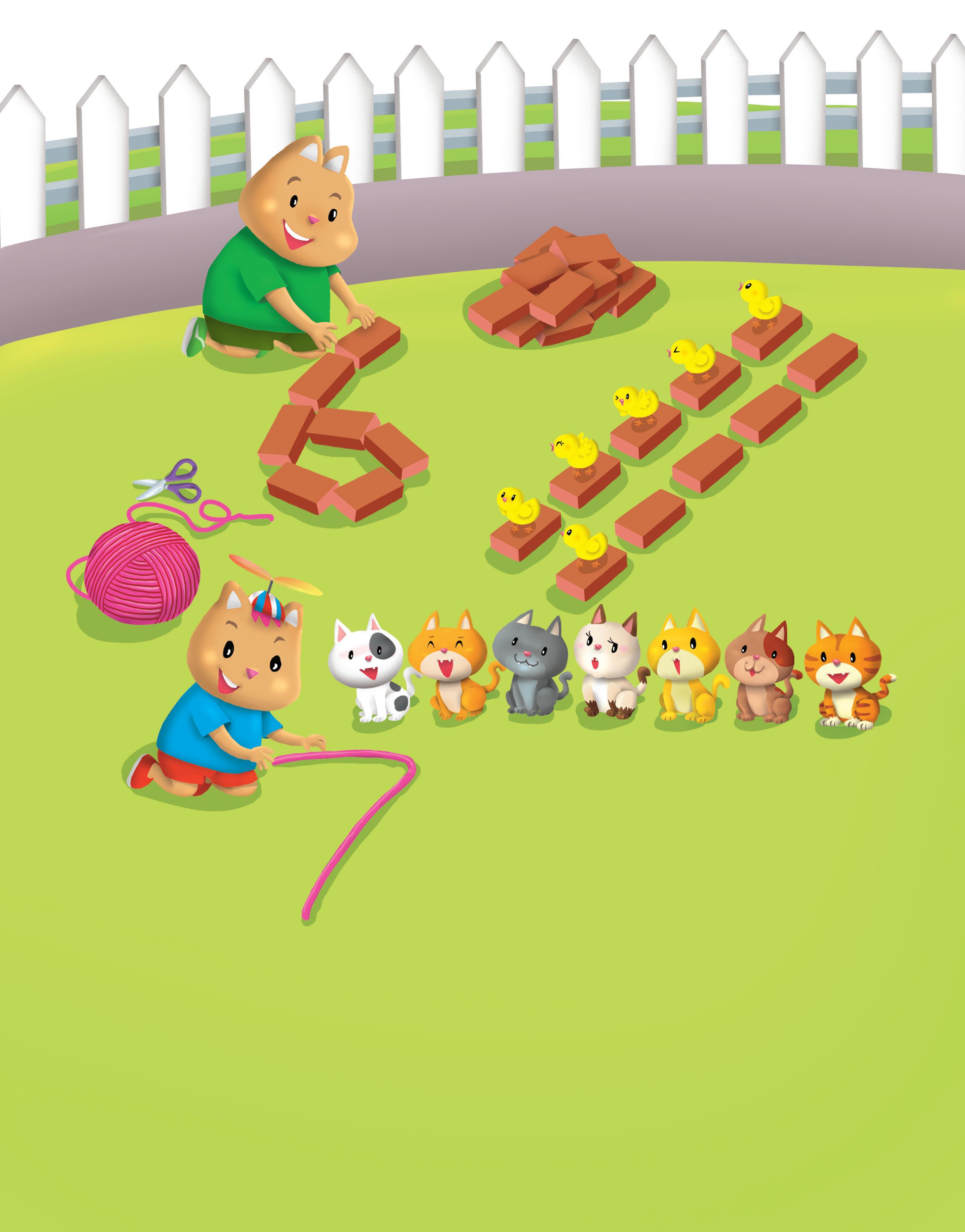
Seven kittens in a line. Little chicks on the bricks. Five chicks in a row. And one more. That makes six.
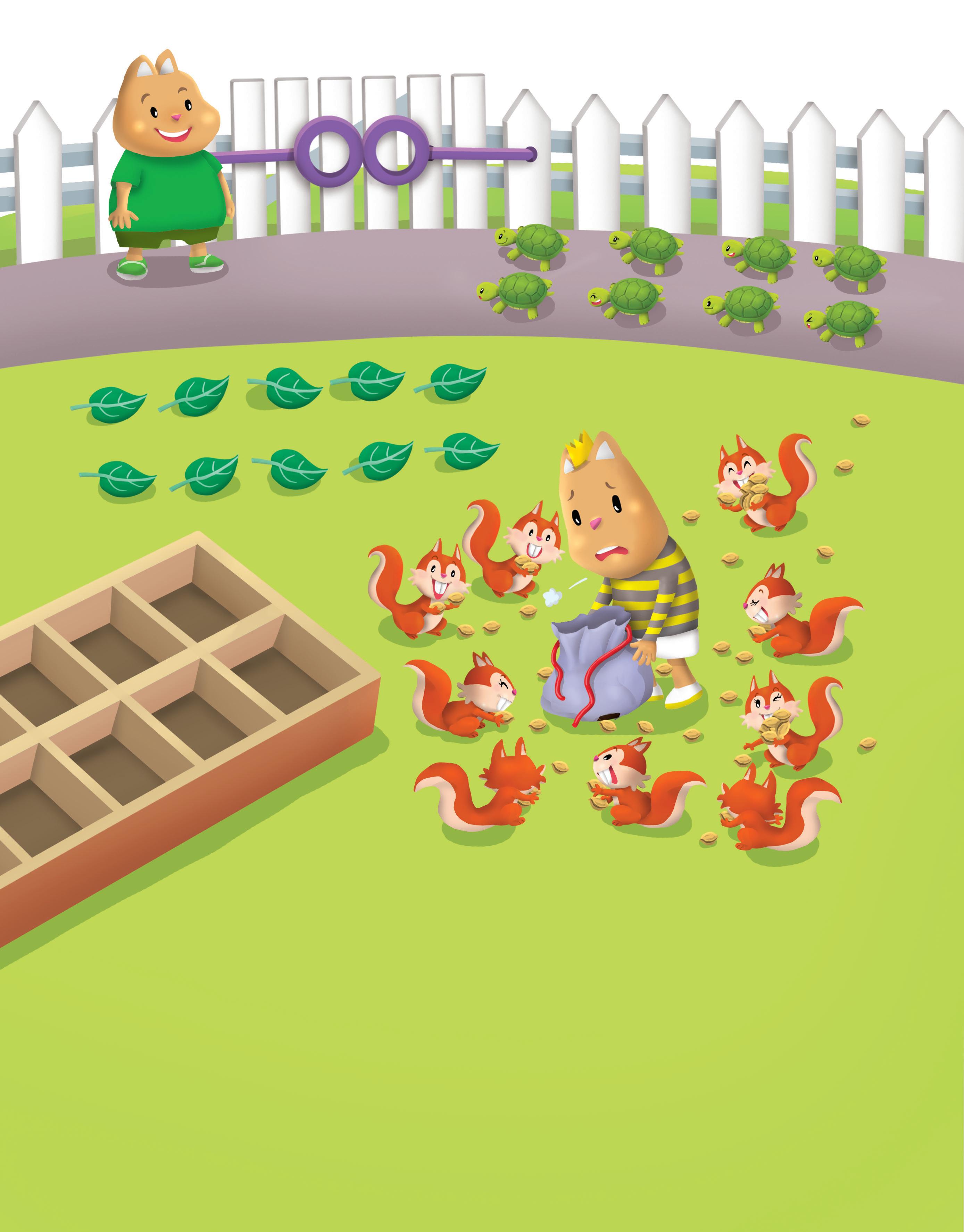
Squirrels busy looking for nuts.
Tortoises walking slowly by.
Are there more or fewer squirrels than tortoises?
Can you tell? Come, let’s try.
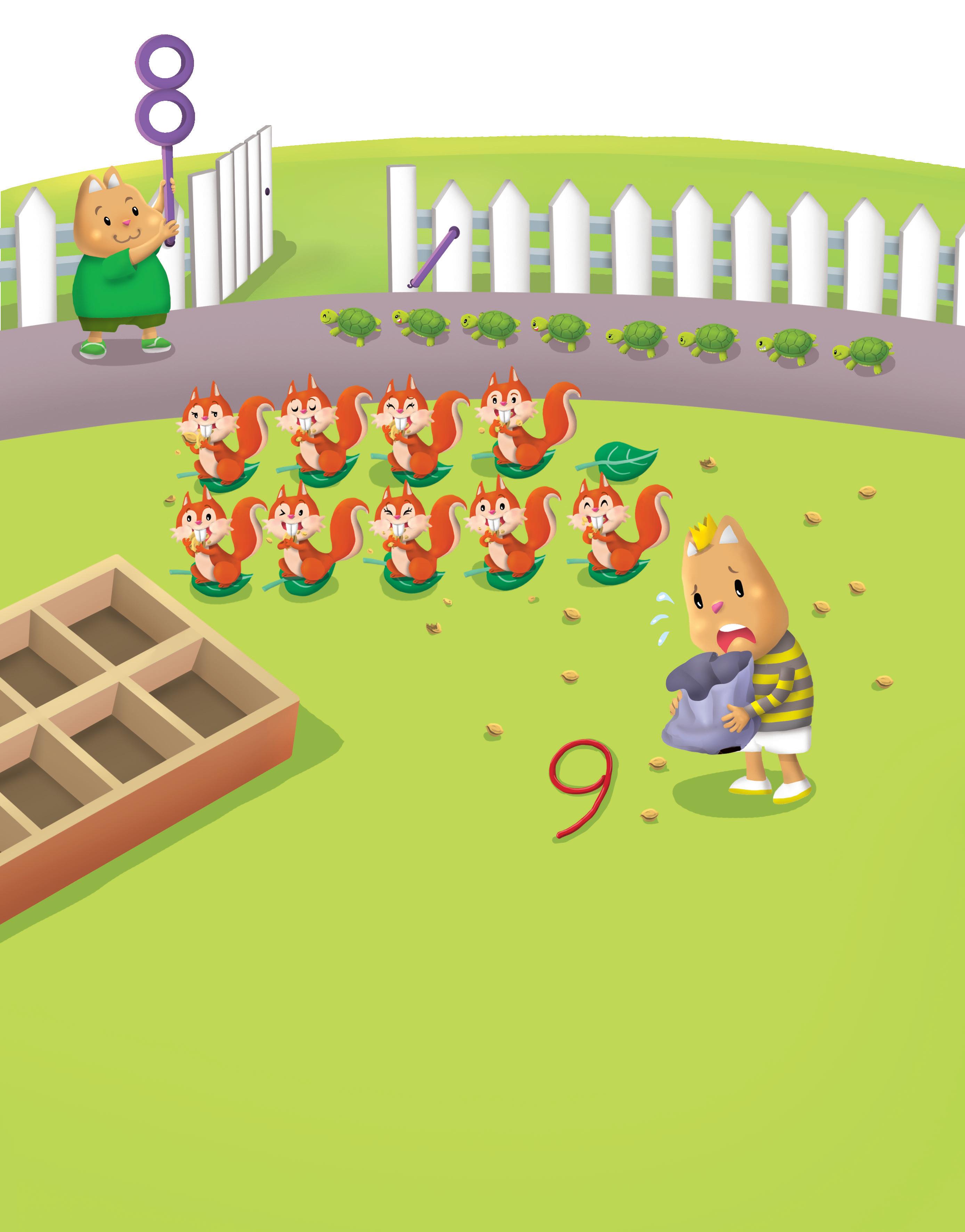
Eight tortoises walk to the gate.
Nine squirrels think nuts taste great!
There are more squirrels and fewer tortoises.
Nine is more than eight.

Rabbits, rabbits hopping about.
How many of them are black? Carrots, carrots in the box. Does each rabbit get a snack?


The cats are in their backyard playing with many friendly small animals. Can you count along with them?
Scholastic Mathematics K Problem Solving Kit is a program comprising twenty stories aimed at consolidating students' understanding of core mathematical concepts through solving problems and developing a problem-solving mindset using age-appropriate contexts. Three problems with their accompanying solutions are woven into each story as students solve problems together with the amicable cat family. This problem solving kit can be used as part of the Scholastic Mathematics K Program, or as a standalone program to focus on developing problem solving skills and mindset.
As part of the Scholastic Mathematics K core curriculum, each Big Book is used after the corresponding chapter in the Student Book. Review A covers all the topics in Student Book A, while Review B covers those in Student Book B.
10. Shapes Can Fly Flat Shapes
to
16. Shapes Make Lots of Things Composing and Modeling Shapes 17.








Welcome to Scholastic Mathematics K Problem Solving.
Scholastic Mathematics K Problem Solving has been developed to provide young learners opportunities to apply mathematical concepts learned to ageappropriate scenarios and tasks, for meaningful learning and to develop a problemsolving mindset. The program consolidates and enriches students’ learning and extends from the Scholastic Mathematics K core curriculum program, an innovative world-class mathematics core curriculum program focused on the development of early numeracy and problem-solving skills, based on the effective teaching and learning practices of the global top-performers in Mathematics – Singapore, Republic of Korea and Hong Kong.
The 20 Big Books and Readers and accompanying Problem Solving Teacher’s Guide cover the four strands of mathematics: Numbers and Operations, Measurement, Geometry, and Data Analysis. Each story is filled with mathematically rich illustrations that teachers can discuss with students as they follow the cat family on their adventures. The 20 Big Books and Readers are intended to be used together with the Scholastic Mathematics K core curriculum program and can also be used as an independent problem solving program with any other core curriculum program.





Problem solving underpins mathematics learning in Mathematics K-6 and is a tool for learning mathematics. The stories in the Problem Solving Big Books and Readers provide a context for consolidating learning and developing deep conceptual understanding. As students engage with the stories and encounter the problems the mathematics they have learned becomes meaningful and useful and they learn to apply knowledge acquired to solve the problems and develop the ability to adapt and communicate their thinking. The stories, teacher-led enquiry and accompanying learning-center-based small group, pair and independent work encourage mathematically-rich discussion and communication of mathematical ideas and thinking.
Scholastic Mathematics K Problem Solving Big Books and Readers are intended to be used at the end of each chapter of the core curriculum program so that students can apply the concepts and skills they have learned to meaningful tasks, thus developing a problem-solving mindset.
Each Big Book/Reader aligns to and consolidates the learning objectives covered in the Student Book.
• Big Books / Readers 1 to 9 correspond to Chapters 1-9 in Student Book A.
• Big Books / Readers 10 to 18 correspond to Chapters 10-18 in Student Book B.
• Review A covers mathematical concepts from Big Books / Readers 1-9.
Review B covers mathematical concepts from Big Books / Readers 10-18.












































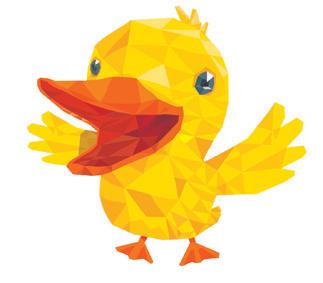






















The diagram below illustrates the instructional pathway of each problem solving lesson in the program.

Teacher arouses the students’ interest in the story through warm up activities such as question-posing, discussion of the cover and book title, and a picture walk to activate prior knowledge and personal experience, and develop connecting and predicting skills.
Interactive read aloud of the book encourages students to actively participate in meaningmaking as they solve problems encountered by the characters and then check their solutions. Students enjoy the story for its own sake while applying the mathematical knowledge acquired.
Learning center activities, which include small group, pair and independent work, provide opportunities for communication and collaboration and for the teacher to informally assess learning through evidence of mastery.
The lessons are designed for gradual release of responsibility for learning from teacher to student and icons alongside the text in the Teacher's Guide indicate the nature of the task.
A wrap-up of the lesson provides opportunities for students to reflect on their learning and to articulate it.
Icons indicate the stages of the gradual release of responsibility model of instruction.
: whole class
: small group
: pair : independent
The lesson starts with a 10-minute warm-up designed to engage students and pique their interest. Teachers pose questions related to the stories and have students look at the illustrations to predict the story.

The Overview provides a quick snapshot of the story and the key features and mathematical concepts and how they are incorporated in the story.

This table lists the Learning Objectives addressed in the story and its related activities.



As each story unfolds during the interactive read aloud, students encounter and solve three problems presented in the context of the story. The corresponding pages of the Teacher's Guide provide a systematic and user-friendly lesson plan for use with the reader, incorporating questions to ask (with suggested answers), things to point out in the illustrations as well as activities to carry out to make the story exciting and engaging, and the learning, meaningful.
Big Book/Reader pages 2-3 introduce the story, its setting and characters, and Problem 1 of the story.
Big Book/Reader page 4 provides the solution to Problem 1.
Big Book/Reader page 5 poses Problem 2.
Big Book/Reader page 6 provides the solution to Problem 2.
Big Book/Reader page 7 poses Problem 3.
Big Book/Reader page 8 provides the solution to Problem 3 and the conclusion of the story.




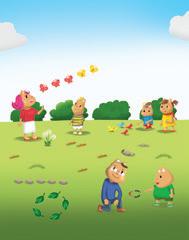

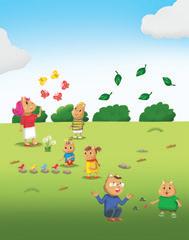





Learning Center Activities after the interactive read aloud provide an opportunity for teachers to informally assess students’ understanding. They include activities for small group, pair and independent work to provide opportunities for collaboration, communication and reflection to demonstrate mastery and for the teacher to evaluate student needs for enrichment or remediation.


Wrap up activities are designed to help students recall and Optional Activities list other opportunities for learning in the Big Book/Reader that the teacher can use for remediation or enrichment.




Karren Schultz-Ferrell is a former elementary classroom teacher with teaching experiences ranging from 2-year-olds through Grade 5. Before retiring, she was an Elementary Integrated Instructional Specialist in Montgomery County Public Schools, MD, collaboratively aligning and writing the district’s mathematics curriculum with the Common Core State Standards for Kindergarten through Grade 5. Karren is a mathematics consultant as well as co-author of Math Misconceptions, PreK-Grade 5: From Misunderstanding to Deep Understanding and Heinemann’s Math Process Standards series, Introduction to Reasoning and Proof (Grades PreK-2, Grades 3-5, and Grades 6-8).
She became involved in the PR1ME Mathematics K program writing because she loves a challenge and teaching math to young children! Karren is the author for both the PRIME Mathematics K Teachers’ Guide, and the Problem Solving Teacher’s Guide.
Judy Ling is the author of the PRIME Mathematics K Problem Solving stories. She is from New Zealand, but has lived in Singapore and Malaysia for most of her adult life. She speaks Mandarin and Bahasa Malaysia. She lives with her family in Sarawak, where she has a preschool and a tuition center. She loves working with and writing for children. Judy has a BA from Auckland University, a diploma in Mandarin from Nanyang University and a diploma in Proofreading and Book Editing from the New Zealand Institute of Business Studies.
She has been authoring books for children for nearly thirty years. She has worked with various international publishers and has written many fiction and non-fiction texts. She has also authored textbooks and workbooks for children from pre-school to secondary level.
Duriya Aziz S W PhD
Though a language specialist by training, math education found her and Dr Aziz has spent almost 20 years developing curriculum programs based on Singapore math pedagogical principles and practices for more than 20 countries, in different languages, and worked with ministries, schools and teachers on the implementation of these programs. She has written several course books, teachers resource materials, readers and published articles on pedagogy and instructional design. She has spent nearly twenty years working with educators on the implementation of the programs around the world, and observing the dynamic interplay between pedagogy and the cultural and social contexts in which they have to operate. Duriya’s focus has been on the development and implementation of programs that incorporate global best practices while remaining culturally and contextually appropriate, to drive sustainable change at a systemic level including development of teacher competence, knowledge, and independence.


The cats are in their backyard playing with friendly small animals.
Students help the cats count sets of animals from 6 to 10 illustrated in a variety of arrangements (in a line, scattered, arrays, 10-frames, circular). Counting concepts and concepts of one-to-one correspondence, keeping track, cardinality and conservation are reinforced. Students revisit counting on from 5 (counting objects in 10-frames), reading and writing numbers from 6 to 10 as well as the number 0, and comparing two sets of objects to determine which set has more, fewer or if both sets have the same number of objects. Additional counting concepts are reinforced through the Learning Center Activities.
Count groups of 6 to 10 objects arranged in a line and in a 10-frame 4, 6, 7, 8
Count on from 5 to count groups of 6 to 10 objects arranged in a 10-frame 4, 6, 7, 8
Read and write 6 to 10 in numeral form and recognize their number names 2, 3, 4, 5, 6, 7, 8
One-to-one correspondence 4, 6, 8
Read and write 0 in numeral form and recognize its number name 8
Count up to 10 objects (in a line, 10-frame, array, circular, scattered) 7, 8
Count out a set of objects (up to 10) from a larger set (not more than 15) 8
State how many objects are in a counted set (up to 10 objects) without recounting objects in the set (cardinality) 2, 3, 4, 5, 6, 7, 8
Write a numeral (0–10) to represent a number of objects (0–10) 4, 6, 8
Identify the number that comes before, after or in between other number(s) 4, 5, 6
Compare two sets with up to 10 objects each by matching; Make comparisons using ‘the same as’, ‘more than’ and ‘fewer than’
State the total of a set of objects when one more/one fewer object is placed in the counted set 5, 6
Write a numeral (0–10) to represent one more/one fewer than a number of objects (1–9)
Vocabulary:
count, arrangement, group/set, straight line, scattered, 10-frame, circle
Introduce the story by posing the following questions.
• What small animals have you seen outdoors?
• Which animal is your favorite? What do you like about this animal?
Have students look at the book cover. Read the story title and encourage students to make a prediction about the story.
Conduct a picture walk and have students briefly describe what they notice about each picture. Once the picture walk is done, ask students whether they would like to change their prediction and to explain their reason.

Materials:
• Sheets of paper for recording answers as necessary
• Bags of 15 connecting cubes (same color), 1 bag per student
• Pointer stick
Problem 1 BB/R pp. 2–3
Give each student a bag of connecting cubes. Read the text to students and ask the following questions.
Ask:
• How are the kittens arranged? (in a circle) How can you remember which kittens have been counted? (E.g. by putting a connecting cube on each kitten as it is counted)
• How are the chicks arranged? (They are scattered everywhere!) How can you count the chicks? (E.g. count the chicks above the rows of bricks and keep on counting the chicks below the rows)


• How many kittens are playing around the ball of yarn? (7) How many chicks are playing beside the bricks? (6) As you count the number of objects in each group, use the pointer stick and point to each object to reinforce one-to-one correspondence.
Solution 1 BB/R p. 4
Read the text to students.
Remind students they counted 7 kittens playing around the ball of yarn. Point out that the kittens are now in a line. Have students recount the group of kittens to confirm that there are 7 kittens.
Ask:
• How are the bricks arranged? (in 2 rows) How is the arrangement like a 10-frame? (There are 2 rows and each row has 5.)
• How many chicks are in the first row? (5) Have students count together. Move your hand across the top row of bricks and say “5”, and then count the chick below as 6.
Say: 5 chicks and 1 more chick make 6 chicks.
Have students look at the bricks and the yarn to identify the numbers that are formed. Then, have students trace the numbers 6 and 7 in the air.
Problem 2 BB/R p. 5
Read the text to students.
Tell students to count out 1 cube for each animal they see in a group.
Ask:
• How many tortoises are walking? (8) How do you know you have 8 tortoises? (E.g. We put the cubes in 2 rows like the picture. We counted 4 and kept on counting 5, 6, 7, 8.)
• How many squirrels are looking for nuts? (9) How do you know you have 9 squirrels? (E.g. We moved each cube aside as we counted.)
Ask students how they would decide which group has more, the tortoises or the squirrels. Support them in using the one-to-one matching strategy using the cubes.
Ask: How can we tell if there are more tortoises or squirrels? Which set has more and which set has fewer? (E.g. We can use the cubes and check if each cube in a group has a partner.)




Solution 2
BB/R p. 6
Read the text to students.
Ask: How did the arrangement of tortoises and squirrels change in this picture? Provide several minutes for a brief discussion.
Say: Count the cubes for the group of tortoises. How many are there? (8) Now count the tortoises on this page. How many are there? (8) Where is the number 8 in the picture? (on the gate/in Bob's hands)
Have students trace the number 8 in the air.
Say: Count the cubes for the group of squirrels. How many are there? (9) Now look at the squirrels on this page. How are the squirrels arranged? (E.g. in two rows, like a 10-frame, with each squirrel sitting on a leaf)
Have students count the squirrels together. Move your hand across the bottom row and say “5”. Then, continue counting the squirrels in the top row, 6, 7, 8, 9.
Say: How many squirrels are there? (9) Where is the number 9 in the picture? (formed by the yarn on the grass)
Have students trace the number 9 in the air.
Ask:
• Are there more tortoises or more squirrels? (more squirrels)

• Which set has fewer animals? (the tortoises) How do you know? (E.g. We paired each tortoise with a squirrel. A squirrel didn’t have a partner so there are more squirrels.)
Problem 3 BB/R p. 7
Read the text to students.
Ask:
• What do you notice about the carrots? (E.g. There is a carrot in each box and the boxes form a 10-frame.)
• How many carrots are there? (10) How do you know? (E.g. The 10-frame is filled so there are 10 carrots./There are 5 carrots in the top row. We count on from 5. 6, 7, 8, 9, 10.)
Have students count the number of gray, white and brown rabbits. Point to each rabbit as you get them to count.
Ask: Are there any black rabbits? (no) What number means there are no black rabbits? (0)
Have students count the number of rabbits in all. Then, ask them if there is a carrot for each rabbit. Ask students how they might find out. (We can see if there is a ‘partner’ for each rabbit.)
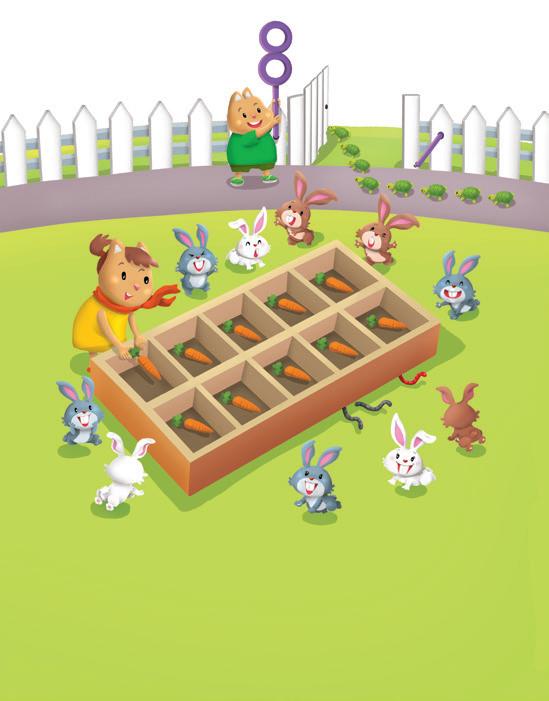
Refer to the artwork on the page and get students to note that there is a ‘partner’ or carrot for each rabbit.
Solution 3 BB/R p. 8
Read the text to students.
Have students count the rabbits and the carrots again.
Ask:
• Are there the same number of carrots as rabbits? (Yes. There are 10 carrots and 10 rabbits.)
• Can each rabbit get a carrot snack? (Yes. There is one rabbit by each carrot.)
Refer to the artwork on the page and get students to note that there is a ‘partner’ for each rabbit.
Point out the number 0 and the number 10 on the page, and get students to trace the numbers in the air.
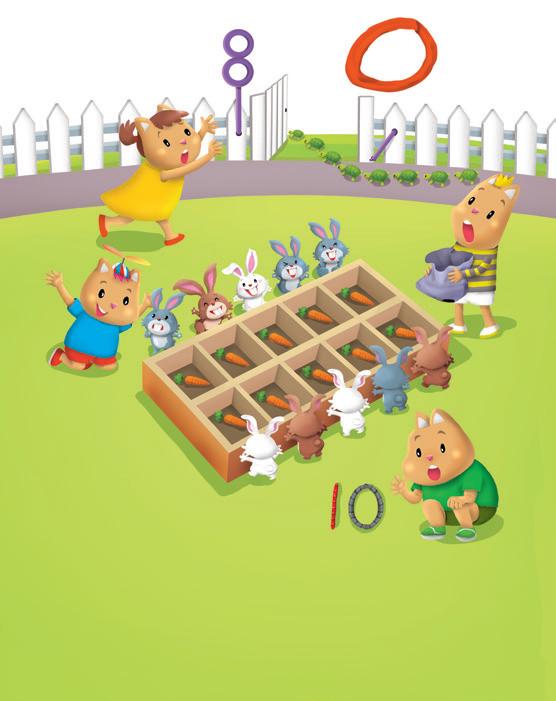

Materials and Resources:
• Number Tapes (TR 2.1a), 1 copy per student
• Number Cards 0–10 (TR 2.1b), 1 set per student
Materials and Resources:
• Counting Strips (TR 2.2), 1 copy per pair
• Bags of connecting cubes (10 red and 10 blue), 1 bag per pair
Distribute a copy of Number Tapes (TR 2.1a) and a set of Number Cards 0–10 (TR 2.1b) to each students.
Have students discuss the order of numbers from 0 to 10.
Explain to students they will complete the Number Tapes by choosing the correct Number Cards and pasting them before, after or in between the other numbers.
Materials and Resources:
• 1 More, 1 Fewer (TR 2.3), 1 copy per student
Ask:
Distribute a copy of Counting Strips (TR 2.2) and a bag of connecting cubes to each pair.
Have each student choose one color of cubes to use.
Explain how the activity is carried out.
• Each partner decides the number of cubes to put on his/her strip and counts out that many cubes from the bag. Remind students not to tell their partners how many cubes they are taking out.
• Each partner then places his/her cubes on one strip on the workmat, one cube per box.

• Pairs then compare their strips and decide who has more cubes, and who has fewer cubes, or if they have the same number of cubes. Remind students to use the terms ‘more than’, ‘fewer than’ and ‘the same as’ to make comparisons.
Distribute a copy of 1 More, 1 Fewer (TR 2.3) to each student.
Explain to students they will draw one more object for the first two questions. They will then count and write the number of objects for the new total.
For the next two questions, students will count the objects in the group and draw one fewer before writing the number of objects for the new total. Activity 2
• What were the different ways the animals were arranged in the story? (scattered, in a line, in rows, in 10-frames, in a circle)
• Does the number of animals change when they are arranged in different ways? Explain your thinking. Draw a number tape 0–10 for students to see.
Ask: What numbers are in between 3 and 8? (4, 5, 6, 7) Do we also count 3 and 8? (no)
• Have students count other animals or objects, such as the leaves, rabbits, tortoises and squirrels on p. 3, and the members of the cat family on pp. 2–3.
• Have students compare the sets of animals/objects on p. 3.
Ask: Are there more squirrels or more tortoises? Are there more rabbits or leaves? Which set has fewer animals in it?
• Challenge students by asking them about Helicopter’s request for a carrot on p. 8. If a rabbit gives him a carrot, will there be enough carrots for all the rabbits? Have students explain their thinking.

0 1 2 3 4 5 6 7 8 10
Paste numbers to complete each number tape.
1. 2. 3. 6 7 4 8 3 4
0 1 2 3 4 5 6 7 8 10
1. Draw one more. Count and write the number.








2. Draw one fewer. Count and write the number.








3 7 5 2